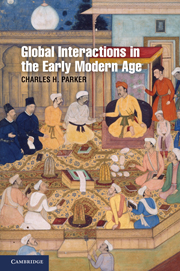Book contents
- Frontmatter
- Contents
- Maps
- Acknowledgments
- Global Interactions in the Early Modern Age, 1400–1800
- Introduction: The Global Integration of Space
- 1 European States and Overseas Empires
- 2 Asian States and Territorial Empires
- 3 International Markets and Global Exchange Networks
- 4 The Movement of Peoples and Diffusion of Cultures
- 5 The Formation of New Demographic and Ecological Structures
- 6 The Transmission of Religion and Culture
- Conclusion: Converging Destinies
- Notes
- Index
- References
Introduction: The Global Integration of Space
Published online by Cambridge University Press: 05 June 2012
- Frontmatter
- Contents
- Maps
- Acknowledgments
- Global Interactions in the Early Modern Age, 1400–1800
- Introduction: The Global Integration of Space
- 1 European States and Overseas Empires
- 2 Asian States and Territorial Empires
- 3 International Markets and Global Exchange Networks
- 4 The Movement of Peoples and Diffusion of Cultures
- 5 The Formation of New Demographic and Ecological Structures
- 6 The Transmission of Religion and Culture
- Conclusion: Converging Destinies
- Notes
- Index
- References
Summary
Traditionally, historians have presented the 1400s and 1500s as the “age of discovery,” when Europeans began to explore, encounter, and exploit territories in Asia, Africa, and America. Yet research over the past twenty-five years has made it increasingly clear that this age of discovery was rooted in extensive contact among peoples across Eurasia (the land mass comprising Europe and Asia) long before Vasco Da Gama landed off the Malabar coast of India in 1498. No episode better illustrates the extent of these intercontinental connections than a fairly well-known anecdote from the initial encounter between Portuguese and Indian officials in Calicut. According to the story, Da Gama prepared to make contact with native peoples shortly after dropping anchor offshore. Apparently he harbored some apprehension about how a foreign Portuguese mariner might be received, so Da Gama selected a convict on board, João Nunez, to go ashore first to see what would happen. Much to the relief of Nunez, and the surprise of Da Gama, local officials recognized him as someone from Iberia (on the western coast of Europe), perhaps even as Portuguese, and took him to two north Africans who were conversant in Castilian and Genoese, languages in Spain and Italy.
The recognition of Nunez as an Iberian, as well as the presence of Africans familiar with two European languages in India, highlight the cosmopolitan character of Asian commercial centers and the prevalence of long-distance travel long before the period of European expansion.
- Type
- Chapter
- Information
- Publisher: Cambridge University PressPrint publication year: 2010



